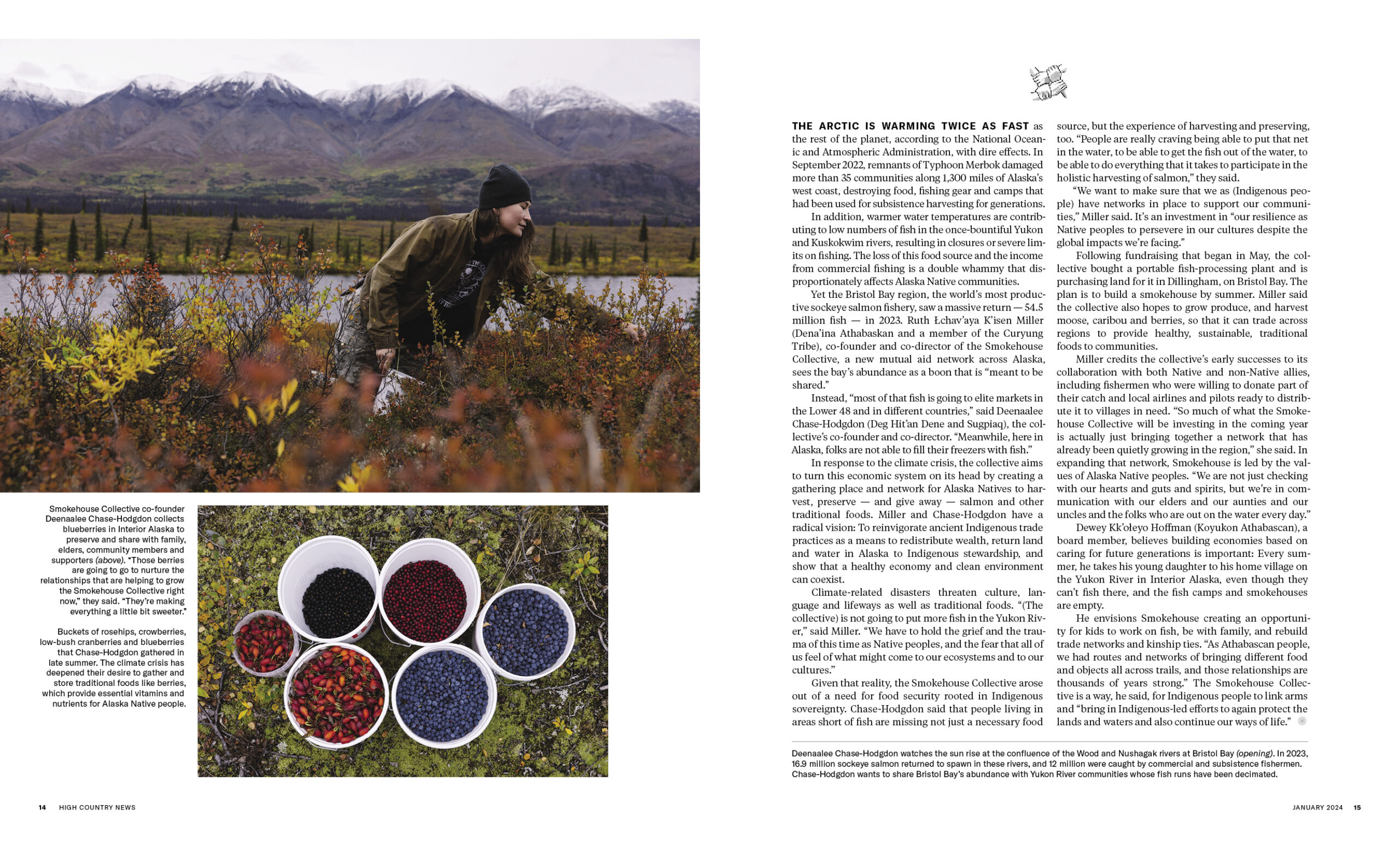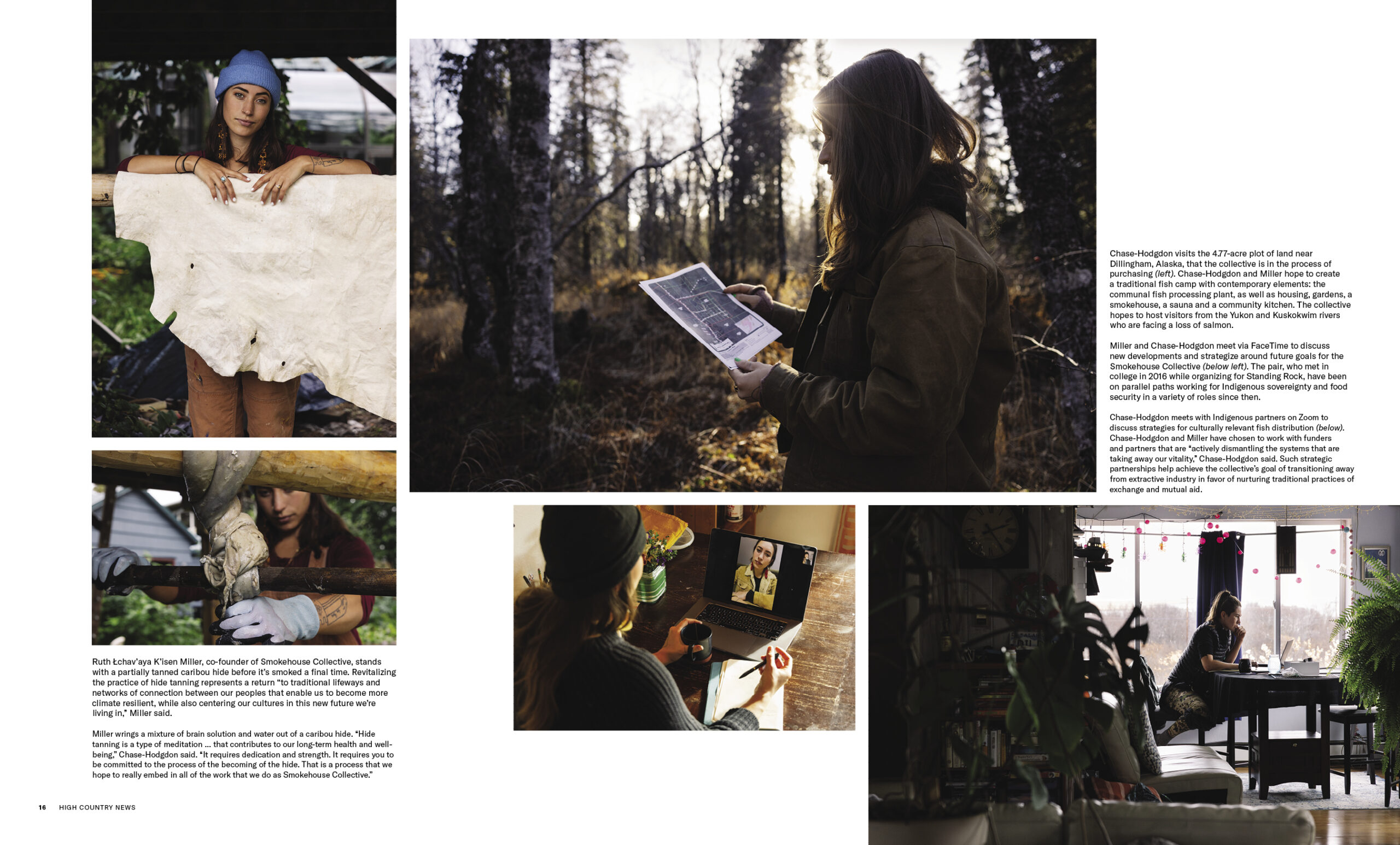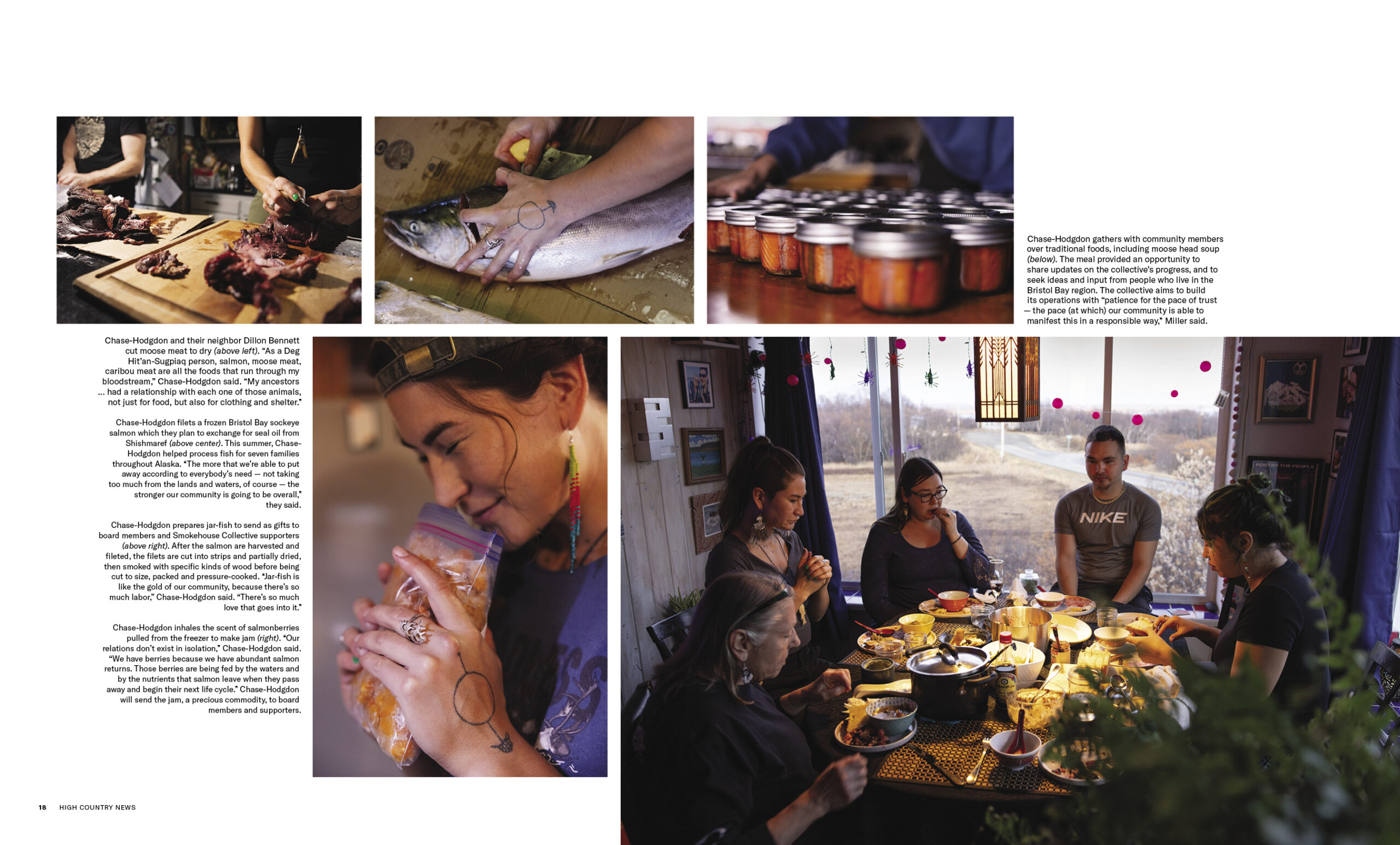



High Country News
Photographer: Emily Sullivan
Photo Editor: Bear Guerra
Heidi: How has your experience as a backcountry guide informed your photography
career, were you an athlete first and then a photographer? No doubt being a
guide took to you some magical places.
Emily: I was a photographer first—I got my BFA at VCU Arts in Richmond, Virginia, where I
fostered a longstanding love of photography and film through large-scale installation
pieces. Much of my time in art school was spent creating imagery that integrated
sculpture into landscapes and vice-versa. I grew up as a city kid, but my passion for
chasing light and landscapes later inspired me to seek out hiking, backcountry skiing,
and other forms of wilderness travel. Working in the outdoor industry as a guide helped
me to develop hard skills that allow me to now travel deeper into the mountains and
other remote locations with my camera.
You’re originally from the South East, what drew you to the vastness and wilds of
Alaska and how long have you been there?
I grew up in Richmond, Virginia, and lived there until I was 22 years old. In my teens, I
was drawn to Alaska with photography in mind—I wanted to experience and document
the unique landscapes that Alaska had to offer. I first came here in early 2010. I didn’t
know a single soul, but I wanted to learn more about the place and experience the land.
I spent the first nine summers guiding hikes and working seasonal jobs in Denali
National Park, then I moved full-time to Anchorage in 2019.
How did you weave your way into the community in AK and eventually, retrace
the (some) steps of the famed naturalist and conservationist, Mandy Murie, a
voice in helping create the Arctic National Wildlife Refuge?
My relationship with the Alaskan landscape eventually inspired me to direct my energy
towards conservation issues. This is how I became more deeply entwined in
community—once I began working on land protections with environmental non-profits, I
became invested and involved with others doing similar work.
I was originally inspired to travel through the Arctic National Wildlife Refuge following
Mardy Murie’s steps to raise awareness for the importance of protecting the
Refuge’s coastal plain from oil and gas development. It wasn’t until later that I began to
understand how integral Indigenous land protectors have been to these issues, though
conservationists like the Muries are more widely celebrated. I also began to learn about
some of the harms of conservation—how designated Wilderness can prevent
Indigenous communities from accessing or hunting in their ancestral homelands.
Since then, I’ve turned my attention and efforts toward uplifting Indigenous knowledge
and stories in conservation work. My last four visits to the Arctic National Wildlife
Refuge has been with Indigenous land protectors involved in a project called the
Imago Initiative, who have taught me so much about the importance of ancestral
reciprocity with lands and waters.
Tell us how you met Deenaalee Chase-Hodgdon and learn about their Smoke
House Collective.
Deenaalee and I met when we both worked seasonal jobs in Denali National Park about
ten years ago. We got to know each other better in recent years—Deenaalee is deeply
invested in land and water protections, so our work would sometimes overlap. Alaska is
a huge state with a small population, so our community is relatively tight-knit.
I learned about the Smokehouse Collective when Deenaalee shared an early fundraiser
to help the Collective purchase a commercial fishing permit. I loved what Ruth and
Deenaalee were aiming to do—reclaim cultural practices while redistributing fish,
berries, and other foods to communities that are experiencing food insecurity due to
colonization and the climate crisis. I wanted to support this work in any way possible.
How many days did you spend with her and what was the conversation in
between photo moments?
I spent a few days with Deenaalee in Interior Alaska, one day with their co-founder Ruth
in Anchorage, and then six more days in Dillingham with Deenaalee. We hadn’t planned
to shoot in such a concentrated manner, but plans changed a few times due to illness
and travel commitments. I was very appreciative of the trust Deenaalee showed me by
inviting me to join them in Dillingham. Shooting in small communities in Alaska requires
trust from the community and awareness of cultural norms and consent.
Deenaalee had established relationships in Dillingham from their time there as a
fisherman, but had just moved there full-time after a long period of nomadic movement
throughout Alaska. Between photo moments, Deenaalee was not only trying to get their
new home set up, but they were attending meetings with funders and partner
organizations, connecting with community members over Smokehouse initiatives, and
doing a lot of the behind-the-scenes work of getting the Collective up and running.
This made for interesting reporting as I got to learn a lot of the background of the nuts-
and-bolts of establishing a grassroots non-profit like the Smokehouse Collective.
Deenaalee and I even attended a local meeting of the federal Subsistence Advisory Council in Dillingham. These “down moments” added a lot of context to the story the
photo essay would tell. The on-the-ground reporting inspired us to run the image
captions in long form, adding nuance to the wonderful written intro by Joaqlin Estus.
How did this project come about and what is the Climate Futures Fund?
In August, I received a call for pitches for a photo grant offered by High Country News,
specifically seeking to tell stories of climate resilience. HCN offers such grants a few
times a year to support assignment-based photo essays for their special issues. The
Climate Futures Special Issue was focused on sharing the message that “it’s not too
late to create a better climate future,” and I thought Smokehouse was a great example
of boots-on-the-ground work towards creating climate resilience in Alaska. I reached out
to Deenaalee for a pre-interview, and then I wrote a 500-word pitch explaining my approach.
In September, I was awarded the grant. The final edit was due in November. HCN and I
agreed that the story would benefit from an Alaska Native writer, and the magazine
assigned the intro text to Tlingit journalist Joaqlin Estus.
What type of direction did you get from the HCN, most notably from the photo
editor Bear Guerra.
I met with photo editor Bear Guerra and issue editor Emily Benson a couple of times
before beginning my reporting, and then I met with Bear several times throughout the
assignment. He prompted me to consider how we could visualize the early phases of
Smokehouse’s resource distribution (Deenaalee jarring salmon), encouraged me to
show the behind-the-scenes work of establishing the Collective (Deenaalee and Ruth
meet on video calls), and helped me think through a number of challenges that arose
during my reporting.
A few of the scenes I hoped to capture were just not possible, so Bear provided
encouragement and was a great thought partner in pivoting towards what was possible.
I came back from Dillingham with more images and scenes than we could use
in the story, so Bear gave me an opportunity to cull and choose my own favorite images
before he curated the final set. I’m really happy with the set of images Bear ultimately
selected, and his input as a photo editor was vital to telling a cohesive story.